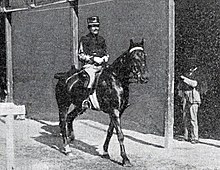Five equestrian competitions were held from 29 May to 2 June 1900 at the Concours Hippique International in Paris as part of the Exposition Universelle. The events were later classified as part of the 1900 Summer Olympics. The events were organised by the Société hippique française, with competitors from eight countries competing in three jumping and two driving events at the Place de Breteuil in the 7th arrondissement of Paris.

At the 1900 Summer Olympics one gymnastics event for men was contested. The competition was held on Sunday, 29 July 1900, and on Monday, 30 July 1900. There were 135 competitors from 8 nations. The top 18 places were taken by French gymnasts, of which there were more than 100. The event was won by Gustave Sandras, with Noël Bas finishing second and Lucien Démanet third. The highest-placing foreign gymnast was Jules Ducret of Switzerland, in a tie for 19th place.

The men's high jump was a track & field athletics event at the 1900 Summer Olympics in Paris. It was held on July 15, 1900. Eight athletes from seven nations competed in the high jump. The event was won by Irving Baxter of the United States, the nation's second consecutive victory in the men's high jump. Great Britain and Hungary each took medals in their first appearance in the event.

The men's standing high jump was a track & field athletics event at the 1900 Summer Olympics in Paris. It was held on July 16, 1900. Three athletes, all from the United States, competed in the standing high jump. The event was won by Ray Ewry of the United States, who took gold in all three of the standing jumps in 1900. His teammate Irving Baxter earned silver in all three 1900 standing jumps. The American sweep was completed with Lewis Sheldon taking bronze.
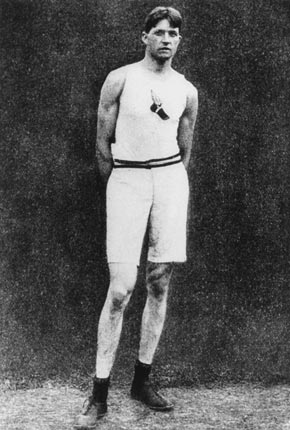
The men's standing triple jump was a track & field athletics event at the 1900 Summer Olympics in Paris, France. It was held on July 16, 1900. 10 athletes from four nations competed in the standing triple jump. The event was won by Ray Ewry of the United States, who took gold in all three of the standing jumps in 1900. His teammate Irving Baxter earned silver in all three 1900 standing jumps. The American sweep was completed with Robert Garrett taking bronze.

Belgium competed at the 1900 Summer Olympics in Paris, France. It was the first appearance of the European nation. Belgium was represented in France by 78 athletes, all of them male, who competed in 11 disciplines. They comprised 95 entries in 28 events.

The Russian Empire competed at the 1900 Summer Olympics in Paris. It was the first appearance of the European nation, which had entered the names of competitors for the first modern Olympics in 1896 but had failed to appear.

The individual show jumping was an equestrian event held as part of the Equestrian at the 1964 Summer Olympics programme. The event was held on 24 October. There were 46 competitors from 17 nations. Each nation could have up to three riders. The event was won by Pierre Jonquères d'Oriola of France, the first rider to win two gold medals in individual jumping; he did so 12 years apart, with his first in 1952. It was France's third gold medal in the event overall, moving out of a tie with Italy at two for most all-time. Hermann Schridde, representing the United Team of Germany, took silver. Great Britain earned its second consecutive bronze in the event, this time with Peter Robeson taking the honors.

The individual show jumping was an equestrian event held as part of the Equestrian at the 1912 Summer Olympics programme. The competition was held on 16 July 1912 as the Stockholm Olympic Stadium. There were 31 competitors from 8 nations. Each nation was limited to a maximum of six riders. The event was won by Jacques Cariou of France, the nation's first victory in the individual jumping. The victory came with a challenge prize presented by Count Gyula Andrássy the Younger of Hungary. Rabod von Kröcher earned Germany's first medal in the event with his silver. Emmanuel de Blommaert of Belgium took bronze.

The high jump was one of five equestrian competitions held in late May and early June 1900 at the International Horse Show in Paris. The event was part of the Exposition Universelle, and later classified as part of the 1900 Summer Olympics. It is the only Olympic Games to date to feature an equestrian high jump competition. Nineteen competitors entered the high jump competition, although not all details have been discovered.

The long jump was one of five equestrian competitions held in late May and early June 1900 at the International Horse Show in Paris. The event was part of the Exposition Universelle, and later classified as part of the 1900 Summer Olympics. It is the only Olympic Games to feature an equestrian long jump competition. Of the seventeen competitors who entered, around half are known by name. The event was won by Constant van Langhendonck of Belgium, with Gian Giorgio Trissino of Italy in second and Jacques de Prunelé of France in third.

The "hacks and hunter combined", also known as the "chevaux de selle", was one of five equestrian competitions held in late May and early June 1900 at the International Horse Show in Paris. The event was part of the Exposition Universelle, and later classified as part of the 1900 Summer Olympics. It is unknown how many riders competed. The top four placers are known, as are about half the remaining riders who competed, including three women. As an upper limit, 50 men and 1 woman are listed as entrants in the Official Report, but it is almost certain that not all actually competed.
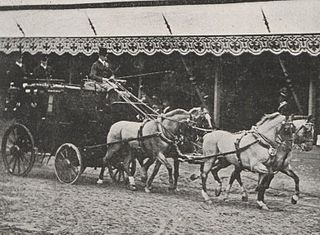
The four-in-hand mail coach driving was one of five equestrian competitions held in late May and early June 1900 at the International Horse Show in Paris. The event was part of the Exposition Universelle, and later classified as part of the 1900 Summer Olympics. There were 31 entrants listed for the event; all 28 of them are known by name. The event was won by the team of Georges Nagelmackers of Belgium. The teams of Léon Thome and Jean de Neuflize, both of France, were classified in second and third place respectively.

The individual show jumping event was part of the equestrian programme at the 1920 Summer Olympics. The competition was held on 12 September at the Olympisch Stadion in Antwerp. There were 25 competitors from 6 nations. The event was won by Tommaso Lequio di Assaba of Italy, with his teammate Alessandro Valerio earning silver. Carl Gustaf Lewenhaupt of Sweden took bronze. They were the first medals in individual jumping for both nations.

The individual show jumping was one of five equestrianism events on the Equestrian at the 1924 Summer Olympics programme. The competition was held on Saturday 27 July 1924. 43 riders from 11 nations competed. Nations were limited to four riders each; the team jumping event used the same results as this competition, with the top three individual scores counting for each national team. The individual event was won by Alphonse Gemuseus of Switzerland, with the nation winning its first victory in its debut in the individual jumping event. Tommaso Lequio di Assaba of Italy became the first person to win multiple medals in the event, taking silver to add to his 1920 gold. Adam Królikiewicz earned Poland's first individual jumping medal with his bronze.

The individual show jumping at the 1928 Summer Olympics took place on 12 August 1928 at the Olympic Stadium in Amsterdam. Scores from the individual competition were summed to give results in the team competition. There were 46 competitors from 16 nations. Each nation could send a team of three riders; 15 nations did so, while Japan had a single rider. The event was won by František Ventura of Czechoslovakia, the nation's first medal in individual jumping. France earned its first medal in the event since 1912 with Pierre Bertran de Balanda's silver. Charles-Gustave Kuhn took bronze, putting Switzerland on the podium for the second consecutive Games.
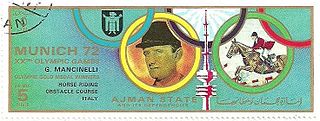
The individual show jumping in equestrian at the 1972 Summer Olympics in Munich was held at Olympic Stadium on 3 September. It was open to men and women. There were 54 competitors from 21 nations, with two additional non-starters. The event was won by Graziano Mancinelli of Italy, the nation's first victory in individual jumping since 1960 and third overall, tying France for most of all nations. Great Britain extended its podium streak in the event to four Games with Ann Moore's silver. The United States reach the podium for a second straight Games as Neal Shapiro took bronze.
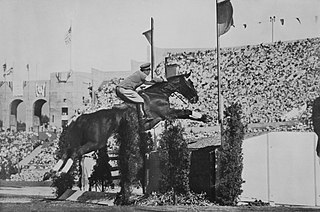
The individual show jumping in equestrian at the 1932 Summer Olympics in Los Angeles was held on 14 August. The event was called the "Prix des Nations" at the time. There were 14 competitors from 4 nations.

The individual show jumping at the 1960 Summer Olympics took place on 7 September, at the Stadio Olimpico. The event was open to men and women. It was the 11th appearance of the event. There were 60 competitors from 23 nations. Each nation could have up to three riders. The event was won by Raimondo D'Inzeo of Italy, with his elder brother Piero D'Inzeo taking silver. The brothers were the second and third riders to win multiple medals in individual jumping; all three were Italian. It was the nation's first gold medal in the event since Lequio di Assaba's in 1920; Italy's two golds tied France for most all-time. David Broome earned Great Britain's first medal in the event with his bronze.
